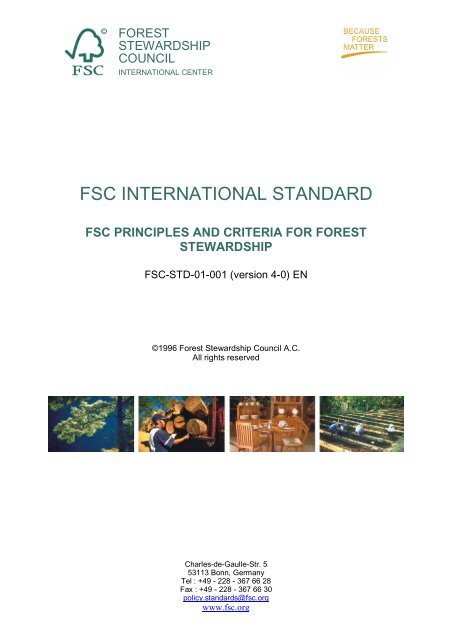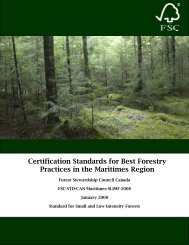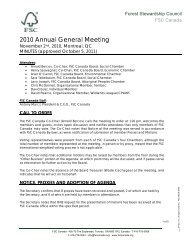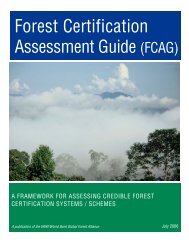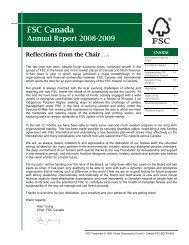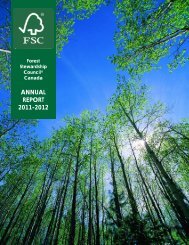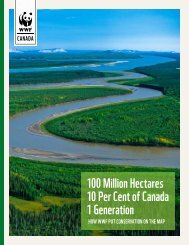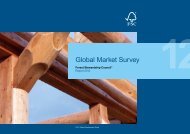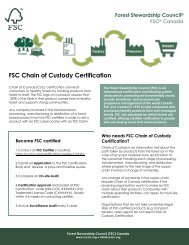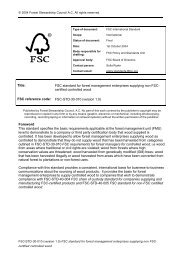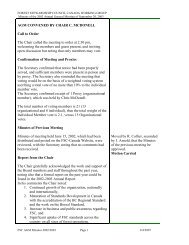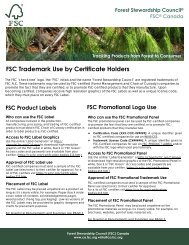FSC-STD-01-001 V4-0 EN FSC Principles and Criteria - Forest ...
FSC-STD-01-001 V4-0 EN FSC Principles and Criteria - Forest ...
FSC-STD-01-001 V4-0 EN FSC Principles and Criteria - Forest ...
- No tags were found...
Create successful ePaper yourself
Turn your PDF publications into a flip-book with our unique Google optimized e-Paper software.
FORESTSTEWARDSHIPCOUNCILINTERNATIONAL C<strong>EN</strong>TER<strong>FSC</strong> INTERNATIONAL STANDARD<strong>FSC</strong> PRINCIPLES AND CRITERIA FOR FORESTSTEWARDSHIP<strong>FSC</strong>-<strong>STD</strong>-<strong>01</strong>-0<strong>01</strong> (version 4-0) <strong>EN</strong>©1996 <strong>Forest</strong> Stewardship Council A.C.All rights reservedCharles-de-Gaulle-Str. 553113 Bonn, GermanyTel : +49 - 228 - 367 66 28Fax : +49 - 228 - 367 66 30policy.st<strong>and</strong>ards@fsc.orgwww.fsc.org
© 1996 <strong>Forest</strong> Stewardship Council A.C. All rights reserved.<strong>FSC</strong> PRINCIPLES AND CRITERIA FOR FOREST STEWARDSHIP<strong>FSC</strong>-<strong>STD</strong>-<strong>01</strong>-0<strong>01</strong> (version 4-0) <strong>EN</strong>Approved 1993Amended 1996, 1999, 2002©1996 <strong>Forest</strong> Stewardship Council, A.C. All rights reserved. No part of this work covered by thepublisher’s copyright may be reproduced or copied in any form or by any means (graphic, electronicor mechanical, including photocopying, recording, recording taping, or information retrieval systems)without the written permission of the publisher.The <strong>Forest</strong> Stewardship Council (<strong>FSC</strong>) is an independent, not for profit, non-governmentorganisation based in Bonn, Germany.The mission of the <strong>Forest</strong> Stewardship Council is to support environmentally appropriate,socially beneficial, <strong>and</strong> economically viable management of the world's forests.<strong>FSC</strong> develops, supports <strong>and</strong> promotes international, national <strong>and</strong> provincial st<strong>and</strong>ards in linewith its mission; evaluates, accredits <strong>and</strong> monitors certification bodies which verify the use of<strong>FSC</strong> st<strong>and</strong>ards; provides training <strong>and</strong> information; <strong>and</strong> promotes the use of products that carrythe <strong>FSC</strong> logo.<strong>FSC</strong>-<strong>STD</strong>-<strong>01</strong>-0<strong>01</strong> <strong>V4</strong>-0 <strong>EN</strong><strong>FSC</strong> <strong>Principles</strong> <strong>and</strong> <strong>Criteria</strong> for <strong>Forest</strong> Stewardship- 2 of 13 -
© 1996 <strong>Forest</strong> Stewardship Council A.C. All rights reserved.ContentsIntroduction1 Principle #1: Compliance with laws <strong>and</strong> <strong>FSC</strong> <strong>Principles</strong>2 Principle #2: Tenure <strong>and</strong> use rights <strong>and</strong> responsibilities3 Principle #3: Indigenous peoples' rights4 Principle #4: Community relations <strong>and</strong> worker's rights5 Principle #5: Benefits from the forest6 Principle #6: Environmental impact7 Principle #7: Management plan8 Principle #8: Monitoring <strong>and</strong> assessment9 Principle #9: Maintenance of high conservation value forests10 Principle #10: PlantationsINTRODUCTIONIt is widely accepted that forest resources <strong>and</strong> associated l<strong>and</strong>s should be managed to meetthe social, economic, ecological, cultural <strong>and</strong> spiritual needs of present <strong>and</strong> futuregenerations. Furthermore, growing public awareness of forest destruction <strong>and</strong> degradationhas led consumers to dem<strong>and</strong> that their purchases of wood <strong>and</strong> other forest products will notcontribute to this destruction but rather help to secure forest resources for the future. Inresponse to these dem<strong>and</strong>s, certification <strong>and</strong> self-certification programs of wood productshave proliferated in the marketplace.The <strong>Forest</strong> Stewardship Council (<strong>FSC</strong>) is an international body which accredits certificationorganizations in order to guarantee the authenticity of their claims. In all cases the processof certification will be initiated voluntarily by forest owners <strong>and</strong> managers who request theservices of a certification organization. The goal of <strong>FSC</strong> is to promote environmentallyresponsible, socially beneficial <strong>and</strong> economically viable management of the world's forests,by establishing a worldwide st<strong>and</strong>ard of recognized <strong>and</strong> respected <strong>Principles</strong> of <strong>Forest</strong>Stewardship.The <strong>FSC</strong>'s <strong>Principles</strong> <strong>and</strong> <strong>Criteria</strong> (P&C) apply to all tropical, temperate <strong>and</strong> boreal forests,as addressed in Principle #9 <strong>and</strong> the accompanying glossary. Many of these P&C applyalso to plantations <strong>and</strong> partially replanted forests. More detailed st<strong>and</strong>ards for these <strong>and</strong>other vegetation types may be prepared at national <strong>and</strong> local levels. The P&C are to beincorporated into the evaluation systems <strong>and</strong> st<strong>and</strong>ards of all certification organizationsseeking accreditation by <strong>FSC</strong>. While the P&C are mainly designed for forests managed forthe production of wood products, they are also relevant, to varying degrees, to forestsmanaged for non-timber products <strong>and</strong> other services. The P&C are a complete package tobe considered as a whole, <strong>and</strong> their sequence does not represent an ordering of priority.This document shall be used in conjunction with the <strong>FSC</strong>'s Statutes, Procedures forAccreditation <strong>and</strong> Guidelines for Certifiers.<strong>FSC</strong> <strong>and</strong> <strong>FSC</strong>-accredited certification organizations will not insist on perfection in satisfyingthe P&C. However, major failures in any individual <strong>Principles</strong> will normally disqualify ac<strong>and</strong>idate from certification, or will lead to decertification. These decisions will be taken byindividual certifiers, <strong>and</strong> guided by the extent to which each Criterion is satisfied, <strong>and</strong> by theimportance <strong>and</strong> consequences of failures. Some flexibility will be allowed to cope with localcircumstances.The scale <strong>and</strong> intensity of forest management operations, the uniqueness of the affectedresources, <strong>and</strong> the relative ecological fragility of the forest will be considered in allcertification assessments. Differences <strong>and</strong> difficulties of interpretation of the P&C will beaddressed in national <strong>and</strong> local forest stewardship st<strong>and</strong>ards. These st<strong>and</strong>ards are to bedeveloped in each country or region involved, <strong>and</strong> will be evaluated for purposes ofcertification, by certifiers <strong>and</strong> other involved <strong>and</strong> affected parties on a case by case basis. If<strong>FSC</strong>-<strong>STD</strong>-<strong>01</strong>-0<strong>01</strong> <strong>V4</strong>-0 <strong>EN</strong><strong>FSC</strong> <strong>Principles</strong> <strong>and</strong> <strong>Criteria</strong> for <strong>Forest</strong> Stewardship- 3 of 13 -
© 1996 <strong>Forest</strong> Stewardship Council A.C. All rights reserved.necessary, <strong>FSC</strong> dispute resolution mechanisms may also be called upon during the courseof assessment. More information <strong>and</strong> guidance about the certification <strong>and</strong> accreditationprocess is included in the <strong>FSC</strong> Statutes, Accreditation Procedures, <strong>and</strong> Guidelines forCertifiers.The <strong>FSC</strong> P&C should be used in conjunction with national <strong>and</strong> international laws <strong>and</strong>regulations. <strong>FSC</strong> intends to complement, not supplant, other initiatives that supportresponsible forest management worldwide.The <strong>FSC</strong> will conduct educational activities to increase public awareness of the importanceof the following:*improving forest management;*incorporating the full costs of management <strong>and</strong> production into the price of forest products;* promoting the highest <strong>and</strong> best use of forest resources;*reducing damage <strong>and</strong> waste; <strong>and</strong>*avoiding over-consumption <strong>and</strong> over-harvesting.<strong>FSC</strong> will also provide guidance to policy makers on these issues, including improving forestmanagement legislation <strong>and</strong> policies.1 Principle #1: Compliance with laws <strong>and</strong> <strong>FSC</strong> <strong>Principles</strong><strong>Forest</strong> management shall respect all applicable laws of the country in which theyoccur, <strong>and</strong> international treaties <strong>and</strong> agreements to which the country is a signatory,<strong>and</strong> comply with all <strong>FSC</strong> <strong>Principles</strong> <strong>and</strong> <strong>Criteria</strong>.1.1 <strong>Forest</strong> management shall respect all national <strong>and</strong> local laws <strong>and</strong> administrativerequirements.1.2 All applicable <strong>and</strong> legally prescribed fees, royalties, taxes <strong>and</strong> other charges shall bepaid.1.3 In signatory countries, the provisions of all binding international agreements such asCITES, ILO Conventions, ITTA, <strong>and</strong> Convention on Biological Diversity, shall berespected.1.4 Conflicts between laws, regulations <strong>and</strong> the <strong>FSC</strong> <strong>Principles</strong> <strong>and</strong> <strong>Criteria</strong> shall beevaluated for the purposes of certification, on a case by case basis, by the certifiers<strong>and</strong> the involved or affected parties.1.5 <strong>Forest</strong> management areas should be protected from illegal harvesting, settlement<strong>and</strong> other unauthorized activities.1.6 <strong>Forest</strong> managers shall demonstrate a long-term commitment to adhere to the <strong>FSC</strong><strong>Principles</strong> <strong>and</strong> <strong>Criteria</strong>.2 Principle #2: Tenure <strong>and</strong> use rights <strong>and</strong> responsibilitiesLong-term tenure <strong>and</strong> use rights to the l<strong>and</strong> <strong>and</strong> forest resources shall be clearlydefined, documented <strong>and</strong> legally established.2.1 Clear evidence of long-term forest use rights to the l<strong>and</strong> (e.g. l<strong>and</strong> title, customaryrights, or lease agreements) shall be demonstrated.<strong>FSC</strong>-<strong>STD</strong>-<strong>01</strong>-0<strong>01</strong> <strong>V4</strong>-0 <strong>EN</strong><strong>FSC</strong> <strong>Principles</strong> <strong>and</strong> <strong>Criteria</strong> for <strong>Forest</strong> Stewardship- 4 of 13 -
© 1996 <strong>Forest</strong> Stewardship Council A.C. All rights reserved.2.2 Local communities with legal or customary tenure or use rights shall maintain control,to the extent necessary to protect their rights or resources, over forest operationsunless they delegate control with free <strong>and</strong> informed consent to other agencies.2.3 Appropriate mechanisms shall be employed to resolve disputes over tenure claims<strong>and</strong> use rights. The circumstances <strong>and</strong> status of any outst<strong>and</strong>ing disputes will beexplicitly considered in the certification evaluation. Disputes of substantial magnitudeinvolving a significant number of interests will normally disqualify an operation frombeing certified.3 Principle #3: Indigenous peoples' rightsThe legal <strong>and</strong> customary rights of indigenous peoples to own, use <strong>and</strong> manage theirl<strong>and</strong>s, territories, <strong>and</strong> resources shall be recognized <strong>and</strong> respected.3.1 Indigenous peoples shall control forest management on their l<strong>and</strong>s <strong>and</strong> territoriesunless they delegate control with free <strong>and</strong> informed consent to other agencies.3.2 <strong>Forest</strong> management shall not threaten or diminish, either directly or indirectly, theresources or tenure rights of indigenous peoples.3.3 Sites of special cultural, ecological, economic or religious significance to indigenouspeoples shall be clearly identified in cooperation with such peoples, <strong>and</strong> recognized<strong>and</strong> protected by forest managers.3.4 Indigenous peoples shall be compensated for the application of their traditionalknowledge regarding the use of forest species or management systems in forestoperations. This compensation shall be formally agreed upon with their free <strong>and</strong>informed consent before forest operations commence.4 Principle #4: Community relations <strong>and</strong> worker's rights<strong>Forest</strong> management operations shall maintain or enhance the long-term social <strong>and</strong>economic well-being of forest workers <strong>and</strong> local communities.4.1 The communities within, or adjacent to, the forest management area should be givenopportunities for employment, training, <strong>and</strong> other services.4.2 <strong>Forest</strong> management should meet or exceed all applicable laws <strong>and</strong>/or regulationscovering health <strong>and</strong> safety of employees <strong>and</strong> their families.4.3 The rights of workers to organize <strong>and</strong> voluntarily negotiate with their employers shallbe guaranteed as outlined in Conventions 87 <strong>and</strong> 98 of the International LabourOrganisation (ILO).4.4 Management planning <strong>and</strong> operations shall incorporate the results of evaluations ofsocial impact. Consultations shall be maintained with people <strong>and</strong> groups (both men<strong>and</strong> women) directly affected by management operations 1 .4.5 Appropriate mechanisms shall be employed for resolving grievances <strong>and</strong> forproviding fair compensation in the case of loss or damage affecting the legal orcustomary rights, property, resources, or livelihoods of local peoples. Measures shallbe taken to avoid such loss or damage.1 Criterion modified by <strong>FSC</strong> 2002 General Assembly.<strong>FSC</strong>-<strong>STD</strong>-<strong>01</strong>-0<strong>01</strong> <strong>V4</strong>-0 <strong>EN</strong><strong>FSC</strong> <strong>Principles</strong> <strong>and</strong> <strong>Criteria</strong> for <strong>Forest</strong> Stewardship- 5 of 13 -
© 1996 <strong>Forest</strong> Stewardship Council A.C. All rights reserved.5 Principle #5: Benefits from the forest<strong>Forest</strong> management operations shall encourage the efficient use of the forest'smultiple products <strong>and</strong> services to ensure economic viability <strong>and</strong> a wide range ofenvironmental <strong>and</strong> social benefits.5.1 <strong>Forest</strong> management should strive toward economic viability, while taking into accountthe full environmental, social, <strong>and</strong> operational costs of production, <strong>and</strong> ensuring theinvestments necessary to maintain the ecological productivity of the forest.5.2 <strong>Forest</strong> management <strong>and</strong> marketing operations should encourage the optimal use <strong>and</strong>local processing of the forest's diversity of products.5.3 <strong>Forest</strong> management should minimize waste associated with harvesting <strong>and</strong> on-siteprocessing operations <strong>and</strong> avoid damage to other forest resources.5.4 <strong>Forest</strong> management should strive to strengthen <strong>and</strong> diversify the local economy,avoiding dependence on a single forest product.5.5 <strong>Forest</strong> management operations shall recognize, maintain, <strong>and</strong>, where appropriate,enhance the value of forest services <strong>and</strong> resources such as watersheds <strong>and</strong>fisheries.5.6 The rate of harvest of forest products shall not exceed levels which can bepermanently sustained.6 Principle #6: Environmental impact<strong>Forest</strong> management shall conserve biological diversity <strong>and</strong> its associated values,water resources, soils, <strong>and</strong> unique <strong>and</strong> fragile ecosystems <strong>and</strong> l<strong>and</strong>scapes, <strong>and</strong>, byso doing, maintain the ecological functions <strong>and</strong> the integrity of the forest.6.1 Assessment of environmental impacts shall be completed -- appropriate to the scale,intensity of forest management <strong>and</strong> the uniqueness of the affected resources -- <strong>and</strong>adequately integrated into management systems. Assessments shall includel<strong>and</strong>scape level considerations as well as the impacts of on-site processing facilities.Environmental impacts shall be assessed prior to commencement of site-disturbingoperations.6.2 Safeguards shall exist which protect rare, threatened <strong>and</strong> endangered species <strong>and</strong>their habitats (e.g., nesting <strong>and</strong> feeding areas). Conservation zones <strong>and</strong> protectionareas shall be established, appropriate to the scale <strong>and</strong> intensity of forestmanagement <strong>and</strong> the uniqueness of the affected resources. Inappropriate hunting,fishing, trapping <strong>and</strong> collecting shall be controlled.6.3 Ecological functions <strong>and</strong> values shall be maintained intact, enhanced, or restored,including:a) <strong>Forest</strong> regeneration <strong>and</strong> succession.b) Genetic, species, <strong>and</strong> ecosystem diversity.c) Natural cycles that affect the productivity of the forest ecosystem.6.4 Representative samples of existing ecosystems within the l<strong>and</strong>scape shall beprotected in their natural state <strong>and</strong> recorded on maps, appropriate to the scale <strong>and</strong>intensity of operations <strong>and</strong> the uniqueness of the affected resources.<strong>FSC</strong>-<strong>STD</strong>-<strong>01</strong>-0<strong>01</strong> <strong>V4</strong>-0 <strong>EN</strong><strong>FSC</strong> <strong>Principles</strong> <strong>and</strong> <strong>Criteria</strong> for <strong>Forest</strong> Stewardship- 6 of 13 -
© 1996 <strong>Forest</strong> Stewardship Council A.C. All rights reserved.6.5 Written guidelines shall be prepared <strong>and</strong> implemented to: control erosion; minimizeforest damage during harvesting, road construction, <strong>and</strong> all other mechanicaldisturbances; <strong>and</strong> protect water resources.6.6 Management systems shall promote the development <strong>and</strong> adoption ofenvironmentally friendly non-chemical methods of pest management <strong>and</strong> strive toavoid the use of chemical pesticides. World Health Organization Type 1A <strong>and</strong> 1B<strong>and</strong> chlorinated hydrocarbon pesticides; pesticides that are persistent, toxic or whosederivatives remain biologically active <strong>and</strong> accumulate in the food chain beyond theirintended use; as well as any pesticides banned by international agreement, shall beprohibited. If chemicals are used, proper equipment <strong>and</strong> training shall be provided tominimize health <strong>and</strong> environmental risks.6.7 Chemicals, containers, liquid <strong>and</strong> solid non-organic wastes including fuel <strong>and</strong> oil shallbe disposed of in an environmentally appropriate manner at off-site locations.6.8 Use of biological control agents shall be documented, minimized, monitored <strong>and</strong>strictly controlled in accordance with national laws <strong>and</strong> internationally acceptedscientific protocols. Use of genetically modified organisms shall be prohibited.6.9 The use of exotic species shall be carefully controlled <strong>and</strong> actively monitored to avoidadverse ecological impacts.6.10 2 <strong>Forest</strong> conversion to plantations or non-forest l<strong>and</strong> uses shall not occur, except incircumstances where conversion:a) entails a very limited portion of the forest management unit; <strong>and</strong>b) does not occur on high conservation value forest areas; <strong>and</strong>c) will enable clear, substantial, additional, secure, long term conservation benefitsacross the forest management unit.7 Principle #7: Management planA management plan -- appropriate to the scale <strong>and</strong> intensity of the operations -- shallbe written, implemented, <strong>and</strong> kept up to date. The long term objectives ofmanagement, <strong>and</strong> the means of achieving them, shall be clearly stated.7.1 The management plan <strong>and</strong> supporting documents shall provide:a) Management objectives.b) Description of the forest resources to be managed, environmental limitations, l<strong>and</strong>use <strong>and</strong> ownership status, socio-economic conditions, <strong>and</strong> a profile of adjacentl<strong>and</strong>s.c) Description of silvicultural <strong>and</strong>/or other management system, based on the ecologyof the forest in question <strong>and</strong> information gathered through resource inventories.d) Rationale for rate of annual harvest <strong>and</strong> species selection.e) Provisions for monitoring of forest growth <strong>and</strong> dynamics.2 Criterion 6.10 was ratified by the <strong>FSC</strong> Members <strong>and</strong> Board of Directors in January 1999.<strong>FSC</strong>-<strong>STD</strong>-<strong>01</strong>-0<strong>01</strong> <strong>V4</strong>-0 <strong>EN</strong><strong>FSC</strong> <strong>Principles</strong> <strong>and</strong> <strong>Criteria</strong> for <strong>Forest</strong> Stewardship- 7 of 13 -
© 1996 <strong>Forest</strong> Stewardship Council A.C. All rights reserved.f) Environmental safeguards based on environmental assessments.g) Plans for the identification <strong>and</strong> protection of rare, threatened <strong>and</strong> endangeredspecies.h) Maps describing the forest resource base including protected areas, plannedmanagement activities <strong>and</strong> l<strong>and</strong> ownership.i) Description <strong>and</strong> justification of harvesting techniques <strong>and</strong> equipment to be used.7.2 The management plan shall be periodically revised to incorporate the results ofmonitoring or new scientific <strong>and</strong> technical information, as well as to respond tochanging environmental, social <strong>and</strong> economic circumstances.7.3 <strong>Forest</strong> workers shall receive adequate training <strong>and</strong> supervision to ensure properimplementation of the management plan.7.4 While respecting the confidentiality of information, forest managers shall makepublicly available a summary of the primary elements of the management plan,including those listed in Criterion 7.1.8 Principle #8: Monitoring <strong>and</strong> assessmentMonitoring shall be conducted -- appropriate to the scale <strong>and</strong> intensity of forestmanagement -- to assess the condition of the forest, yields of forest products, chainof custody, management activities <strong>and</strong> their social <strong>and</strong> environmental impacts.8.1 The frequency <strong>and</strong> intensity of monitoring should be determined by the scale <strong>and</strong>intensity of forest management operations as well as the relative complexity <strong>and</strong>fragility of the affected environment. Monitoring procedures should be consistent <strong>and</strong>replicable over time to allow comparison of results <strong>and</strong> assessment of change.8.2 <strong>Forest</strong> management should include the research <strong>and</strong> data collection needed tomonitor, at a minimum, the following indicators:a) Yield of all forest products harvested.b) Growth rates, regeneration <strong>and</strong> condition of the forest.c) Composition <strong>and</strong> observed changes in the flora <strong>and</strong> fauna.d) Environmental <strong>and</strong> social impacts of harvesting <strong>and</strong> other operations.e) Costs, productivity, <strong>and</strong> efficiency of forest management.8.3 Documentation shall be provided by the forest manager to enable monitoring <strong>and</strong>certifying organizations to trace each forest product from its origin, a process knownas the "chain of custody."8.4 The results of monitoring shall be incorporated into the implementation <strong>and</strong> revisionof the management plan.8.5 While respecting the confidentiality of information, forest managers shall makepublicly available a summary of the results of monitoring indicators, including those<strong>FSC</strong>-<strong>STD</strong>-<strong>01</strong>-0<strong>01</strong> <strong>V4</strong>-0 <strong>EN</strong><strong>FSC</strong> <strong>Principles</strong> <strong>and</strong> <strong>Criteria</strong> for <strong>Forest</strong> Stewardship- 8 of 13 -
© 1996 <strong>Forest</strong> Stewardship Council A.C. All rights reserved.of native species, shall be carefully monitored to detect unusual mortality, disease, orinsect outbreaks <strong>and</strong> adverse ecological impacts.10.5 A proportion of the overall forest management area, appropriate to the scale of theplantation <strong>and</strong> to be determined in regional st<strong>and</strong>ards, shall be managed so as torestore the site to a natural forest cover.10.6 Measures shall be taken to maintain or improve soil structure, fertility, <strong>and</strong> biologicalactivity. The techniques <strong>and</strong> rate of harvesting, road <strong>and</strong> trail construction <strong>and</strong>maintenance, <strong>and</strong> the choice of species shall not result in long term soil degradationor adverse impacts on water quality, quantity or substantial deviation from streamcourse drainage patterns.10.7 Measures shall be taken to prevent <strong>and</strong> minimize outbreaks of pests, diseases, fire<strong>and</strong> invasive plant introductions. Integrated pest management shall form anessential part of the management plan, with primary reliance on prevention <strong>and</strong>biological control methods rather than chemical pesticides <strong>and</strong> fertilizers. Plantationmanagement should make every effort to move away from chemical pesticides <strong>and</strong>fertilizers, including their use in nurseries. The use of chemicals is also covered in<strong>Criteria</strong> 6.6 <strong>and</strong> 6.7.10.8 Appropriate to the scale <strong>and</strong> diversity of the operation, monitoring of plantations shallinclude regular assessment of potential on-site <strong>and</strong> off-site ecological <strong>and</strong> socialimpacts, (e.g. natural regeneration, effects on water resources <strong>and</strong> soil fertility, <strong>and</strong>impacts on local welfare <strong>and</strong> social well-being), in addition to those elementsaddressed in principles 8, 6 <strong>and</strong> 4. No species should be planted on a large scaleuntil local trials <strong>and</strong>/or experience have shown that they are ecologically well-adaptedto the site, are not invasive, <strong>and</strong> do not have significant negative ecological impactson other ecosystems. Special attention will be paid to social issues of l<strong>and</strong> acquisitionfor plantations, especially the protection of local rights of ownership, use or access.10.9 5 Plantations established in areas converted from natural forests after November 1994normally shall not qualify for certification. Certification may be allowed incircumstances where sufficient evidence is submitted to the certification body that themanager/owner is not responsible directly or indirectly of such conversion.GLOSSARYWords in this document are used as defined in most st<strong>and</strong>ard English language dictionaries.The precise meaning <strong>and</strong> local interpretation of certain phrases (such as local communities)should be decided in the local context by forest managers <strong>and</strong> certifiers. In this document,the words below are understood as follows:Biological diversity: The variability among living organisms from all sources including,inter alia, terrestrial, marine <strong>and</strong> other aquatic ecosystems <strong>and</strong> the ecological complexes ofwhich they are a part; this includes diversity within species, between species <strong>and</strong> ofecosystems. (see Convention on Biological Diversity, 1992)Biological diversity values: The intrinsic, ecological, genetic, social, economic, scientific,educational, cultural, recreational <strong>and</strong> aesthetic values of biological diversity <strong>and</strong> itscomponents. (see Convention on Biological Diversity, 1992)5 The <strong>FSC</strong> Members <strong>and</strong> Board of Directors ratified Criterion 10.9 in January 1999.<strong>FSC</strong>-<strong>STD</strong>-<strong>01</strong>-0<strong>01</strong> <strong>V4</strong>-0 <strong>EN</strong><strong>FSC</strong> <strong>Principles</strong> <strong>and</strong> <strong>Criteria</strong> for <strong>Forest</strong> Stewardship- 10 of 13 -
© 1996 <strong>Forest</strong> Stewardship Council A.C. All rights reserved.Biological control agents: Living organisms used to eliminate or regulate the population ofother living organisms.Chain of custody: The channel through which products are distributed from their origin inthe forest to their end-use.Chemicals: The range of fertilizers, insecticides, fungicides, <strong>and</strong> hormones which are usedin forest management.Criterion (pl. <strong>Criteria</strong>): A means of judging whether or not a Principle (of foreststewardship) has been fulfilled.Customary rights: Rights which result from a long series of habitual or customary actions,constantly repeated, which have, by such repetition <strong>and</strong> by uninterrupted acquiescence,acquired the force of a law within a geographical or sociological unit.Ecosystem: A community of all plants <strong>and</strong> animals <strong>and</strong> their physical environment,functioning together as an interdependent unit.Endangered species: Any species which is in danger of extinction throughout all or asignificant portion of its range.Exotic species: An introduced species not native or endemic to the area in question.<strong>Forest</strong> integrity: The composition, dynamics, functions <strong>and</strong> structural attributes of a naturalforest.<strong>Forest</strong> management/manager: The people responsible for the operational management ofthe forest resource <strong>and</strong> of the enterprise, as well as the management system <strong>and</strong> structure,<strong>and</strong> the planning <strong>and</strong> field operations.Genetically modified organisms: Biological organisms which have been induced byvarious means to consist of genetic structural changes.Indigenous l<strong>and</strong>s <strong>and</strong> territories: The total environment of the l<strong>and</strong>s, air, water, sea, seaice,flora <strong>and</strong> fauna, <strong>and</strong> other resources which indigenous peoples have traditionally ownedor otherwise occupied or used. (Draft Declaration of the Rights of Indigenous Peoples: PartVI)Indigenous peoples: "The existing descendants of the peoples who inhabited the presentterritory of a country wholly or partially at the time when persons of a different culture orethnic origin arrived there from other parts of the world, overcame them <strong>and</strong>, by conquest,settlement, or other means reduced them to a non-dominant or colonial situation; who todaylive more in conformity with their particular social, economic <strong>and</strong> cultural customs <strong>and</strong>traditions than with the institutions of the country of which they now form a part, under Statestructure which incorporates mainly the national, social <strong>and</strong> cultural characteristics of othersegments of the population which are predominant." (Working definition adopted by the UNWorking Group on Indigenous Peoples).High Conservation Value <strong>Forest</strong>s: High Conservation Value <strong>Forest</strong>s are those thatpossess one or more of the following attributes:a) forest areas containing globally, regionally or nationally significant :concentrations of biodiversity values (e.g. endemism, endangered species, refugia); <strong>and</strong>/orlarge l<strong>and</strong>scape level forests, contained within, or containing the management unit, where<strong>FSC</strong>-<strong>STD</strong>-<strong>01</strong>-0<strong>01</strong> <strong>V4</strong>-0 <strong>EN</strong><strong>FSC</strong> <strong>Principles</strong> <strong>and</strong> <strong>Criteria</strong> for <strong>Forest</strong> Stewardship- 11 of 13 -
© 1996 <strong>Forest</strong> Stewardship Council A.C. All rights reserved.viable populations of most if not all naturally occurring species exist in natural patterns ofdistribution <strong>and</strong> abundanceb) forest areas that are in or contain rare, threatened or endangered ecosystemsc) forest areas that provide basic services of nature in critical situations (e.g. watershedprotection, erosion control)d) forest areas fundamental to meeting basic needs of local communities (e.g. subsistence,health) <strong>and</strong>/or critical to local communities’ traditional cultural identity (areas of cultural,ecological, economic or religious significance identified in cooperation with such localcommunities).L<strong>and</strong>scape: A geographical mosaic composed of interacting ecosystems resulting from theinfluence of geological, topographical, soil, climatic, biotic <strong>and</strong> human interactions in a givenarea.Local laws: Includes all legal norms given by organisms of government whose jurisdiction isless than the national level, such as departmental, municipal <strong>and</strong> customary norms.Long term: The time-scale of the forest owner or manager as manifested by the objectivesof the management plan, the rate of harvesting, <strong>and</strong> the commitment to maintain permanentforest cover. The length of time involved will vary according to the context <strong>and</strong> ecologicalconditions, <strong>and</strong> will be a function of how long it takes a given ecosystem to recover itsnatural structure <strong>and</strong> composition following harvesting or disturbance, or to produce matureor primary conditions.Native species: A species that occurs naturally in the region; endemic to the area.Natural cycles: Nutrient <strong>and</strong> mineral cycling as a result of interactions between soils, water,plants, <strong>and</strong> animals in forest environments that affect the ecological productivity of a givensite.Natural <strong>Forest</strong>: <strong>Forest</strong> areas where many of the principal characteristics <strong>and</strong> key elementsof native ecosystems such as complexity, structure <strong>and</strong> diversity are present, as defined by<strong>FSC</strong> approved national <strong>and</strong> regional st<strong>and</strong>ards of forest management.Non-timber forest products: All forest products except timber, including other materialsobtained from trees such as resins <strong>and</strong> leaves, as well as any other plant <strong>and</strong> animalproducts.Other forest types: <strong>Forest</strong> areas that do not fit the criteria for plantation or natural forests<strong>and</strong> which are defined more specifically by <strong>FSC</strong>-approved national <strong>and</strong> regional st<strong>and</strong>ards offorest stewardship.Plantation: <strong>Forest</strong> areas lacking most of the principal characteristics <strong>and</strong> key elements ofnative ecosystems as defined by <strong>FSC</strong>-approved national <strong>and</strong> regional st<strong>and</strong>ards of foreststewardship, which result from the human activities of either planting, sowing or intensivesilvicultural treatments.Precautionary approach 6 : Tool for the implementation of the precautionary principle.6 The definition of Precautionary Approach was ratified during the 1999 <strong>FSC</strong> General Assembly in June 1999.<strong>FSC</strong>-<strong>STD</strong>-<strong>01</strong>-0<strong>01</strong> <strong>V4</strong>-0 <strong>EN</strong><strong>FSC</strong> <strong>Principles</strong> <strong>and</strong> <strong>Criteria</strong> for <strong>Forest</strong> Stewardship- 12 of 13 -
© 1996 <strong>Forest</strong> Stewardship Council A.C. All rights reserved.Principle: An essential rule or element; in <strong>FSC</strong>'s case, of forest stewardship.Silviculture: The art of producing <strong>and</strong> tending a forest by manipulating its establishment,composition <strong>and</strong> growth to best fulfil the objectives of the owner. This may, or may not,include timber production.Succession: Progressive changes in species composition <strong>and</strong> forest community structurecaused by natural processes (nonhuman) over time.Tenure: Socially defined agreements held by individuals or groups, recognized by legalstatutes or customary practice, regarding the "bundle of rights <strong>and</strong> duties" of ownership,holding, access <strong>and</strong>/or usage of a particular l<strong>and</strong> unit or the associated resources therewithin (such as individual trees, plant species, water, minerals, etc).Threatened species: Any species which is likely to become endangered within theforeseeable future throughout all or a significant portion of its range.Use rights: Rights for the use of forest resources that can be defined by local custom,mutual agreements, or prescribed by other entities holding access rights. These rights mayrestrict the use of particular resources to specific levels of consumption or particularharvesting techniques.<strong>FSC</strong>-<strong>STD</strong>-<strong>01</strong>-0<strong>01</strong> <strong>V4</strong>-0 <strong>EN</strong><strong>FSC</strong> <strong>Principles</strong> <strong>and</strong> <strong>Criteria</strong> for <strong>Forest</strong> Stewardship- 13 of 13 -


